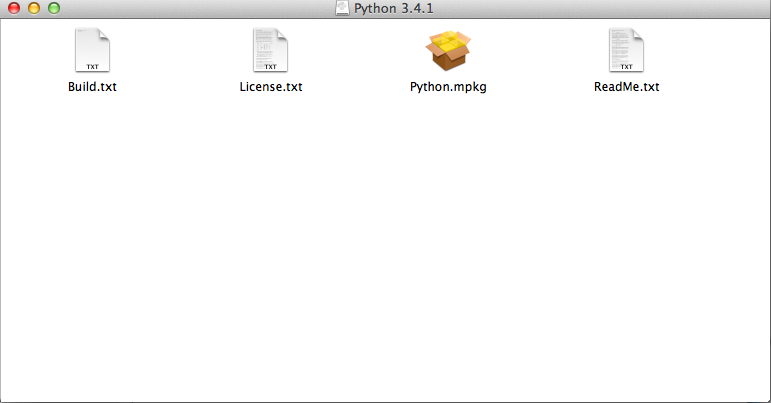Try a faster way of installing Python packages for Windows. Get ActivePython or build your own Python runtime with the packages you need. Get started for free on the ActiveState Platform.
Most Python packages are now designed to be compatible with Python’s pip package manager. But if you have a package that is not compatible with pip, you’ll need manually install Python packages. Here’s how.
Python Installation Checklist
Mac OS needs python. DO NOT remove any versions of Python found in the following folders: /usr/bin; system/Library; These versions of Python—which should be Python 2.7—are installed by Apple and used by Mac OS and other software to perform some functions. We recommend using an user install, sending the -user flag to pip. Pip installs packages for the local user and does not write to the system directories. Preferably, do not use sudo pip, as this combination can cause problems. Pip accesses the Python Package Index, PyPI, which stores almost 200,000 projects and all previous releases of said projects. Because the repository. Prerequisites for installing Python3 on Mac Install Xcode. Xcode is Apple's Integrated Development Environment (IDE). You might already have Xcode on your Mac. See full list on geeksforgeeks.org.
Before installing any package, you should always ensure that a Python installation containing the necessary files needed for installing packages is in place by following the Installation Requirements.
Packages That Cannot be Installed with Pip
Preliminary Steps to take:
- Download the package and extract it into a local directory.
- If the package includes its own set of installation instructions, they should be followed. Otherwise, the most common method for manually installing a package is to implement setup.py.
Installing Python Packages with Setup.py
To install a package that includes a setup.py file, open a command or terminal window and:
- cd into the root directory where setup.py is located
- Enter: python setup.py install
Setup.py Build Environment
Packages installed with setup.py have build requirements that developers must adhere to. However, some requirements are optional.
Examples
- Ensure that an up-to-date version of setuptools is installed:
- Include install_requires keyword arguments in setup.py. install_requires is a setuptools setup.py keyword used to specify minimum package requirements. For example:
Complete package build requirements for a setup.py based installation are outlined by PyPA (Python Packaging Authority) in ‘Sample Project’.
Sample Project
Sample Project is a template package with a setup.py file for manual installation of a package. The file is annotated with comments for customizing the script, and for the overall package build environment. [https://github.com/pypa/sampleproject ]
Sample Project is based on the setuptools package: “A setuptools based setup module.” https://github.com/pypa/sampleproject/blob/master/setup.py ]
setup.py is the build script for packages built with setuptools.
Install Python Library Mac
Setup.py Example (Non-Annotated)
Related Quick Reads:
Install Python packages and automatically resolve dependencies:
If necessary, you can manually install packages in Python. Some packages have special installation requirements. Other packages can be installed manually with setup.py. To manually install packages in Python with setup.py, do the following:
- Download the package and extract it into a local directory.
- Navigate to the directory in which you’ve extracted the package.
- If the package includes its own set of installation instructions, they should be followed. Otherwise, use setup.py by running the following command:
python setup.py install
You may still need the setuptools library to complete the package build requirements.
See how to install pip on Windows.

The most common way to install Python packages is using Python’s package manager, pip. To install a package using pip, run the following command:pip install <packagename>
Where packagename is the name of the package to be uninstalled.
Learn more about installing Python packages with pip.

Pip is installed by default with most Python distributions, but if it is not installed on your local system you can manually install pip by either:

Installing a Python distribution like ActivePython, which includes pip, or manually installing pip with get-pip.py: Download get-pip.py. Navigate to the directory where you installed get-pip.py. Run the following command:python get-pip.py
Learn more about installing pip.
IDLE is Python’s Integrated Development and Learning Environment designed to make learning Python easier. To install Python IDLE packages, you can just use pip by running the following command:pip install <packagename>

Where packagename is the name of the package to be installed.
How to install Python packages using pip.
Maybe it’s just me, but installing the graphics library that’s needed to go through the exercises in John Zelle’s book Python Programming: An Introduction to Computer Science was a lot more difficult than it should have been. Difficult enough that this post is probably more for me than it is for anyone else, but if you’re having trouble installing the graphics library on a Mac, here is how I did it.
First visit the site mentioned in the Appendix of Zelle’s book

Somewhere towards the middle of the page find the graphics.py link, right click it, and copy and paste that into your python project folder (the project your doing your exercises for the book).
Now open up your terminal and run these commands
In my case the terminal returns python 3.5.1
You only need to remember up to tenth decimal place so in my case that’s 3.5. Next you’re going to type this command into the terminal but make sure to replace the two version numbers with the version number of python on your computer
This command will open up the correct folder that you will need to put your graphics.py file in. So, copy the graphics.py from the python project folder and paste it in the folder you just opened up.
To test and make sure you’ve installed graphics.py correctly open up IDLE, and type.
Install Python Library Mac
IDLE should return